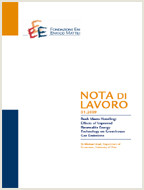Energy efficiency policy with price-quality discrimination

Data
21.04.2015
21.04.2015
Autori
Marie-Laure Nauleau (CIRED); Louis-Gaëtan Giraudet (CIRED, Ecole des Ponts ParisTech); Philippe Quirion (CIRED, CNRS)
Codice JEL
Q4, Q41, Q48
Q4, Q41, Q48
Parole chiave:
Energy Efficiency, Price-Quality Discrimination
Energy Efficiency, Price-Quality Discrimination
Publisher
Climate Change and Sustainable Development
Climate Change and Sustainable Development
Editor
Carlo Carraro
Carlo Carraro
We compare a range of energy efficiency policies in a durable good market subject to both energy-use externalities and price-quality discrimination by a monopolist. We find that the social optimum can be achieved with differentiated subsidies. With ad valorem subsidies, the subsidization of the high-end good leads the monopolist to cut the quality of the low-end good. The rates should always be decreasing in energy efficiency. With per-quality subsidies, there is no such interference and the rates can be increasing if the externality is large enough relative to the market share of low-type consumers. Stand-alone instruments only achieve second-best outcomes. A minimum quality standard may be set at the high-end of the product line if consumers are not too dissimilar, otherwise it should only target the low-end good. An energy tax should be set above the marginal external cost. Likewise, a uniform ad valorem subsidy should be set above the subsidy that would be needed to specifically internalize energy-use externalities. Lastly, if, as is often observed in practice, only the high-end good is to be incentivized, a per-quality schedule should be preferred over an ad valorem one. An ad valorem tax on the high-end good may even be preferred over an ad valorem subsidy if the externality is small enough and low-end consumers dominate the market.
***
Suggested citation: Nauleau, M-L., L-G. Giraudet, P. Quirion, (2015), ‘Energy Efficiency Policy with Price-quality Discrimination’, Energy Economics, Volume 52, Supplement 1, December 2015, Pages S53–S62
